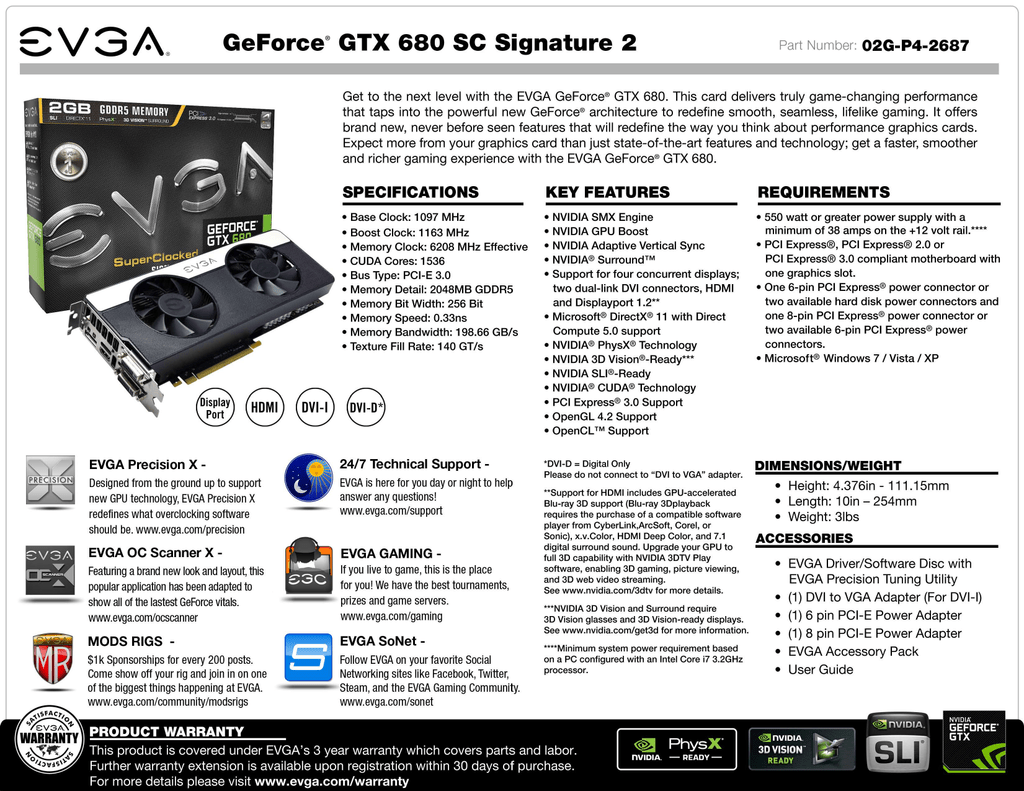


The first tends to occur when framerates are low, the second when framerates are high. NVIDIA Adaptive Vertical SyncNothing is more distracting than framerate stuttering and screen tearing.The result is that the GPU always performs at its peak and you get the highest framerate possible. GPU Boost intelligently monitors graphics work load and increases the clock speed whenever possible. NVIDIA GPU BoostUp until now, GPUs have operated at a fixed clock speed when playing 3D games, even if they have the potential to run faster.The result is world class performance and the highest image quality in an elegant and power efficient graphics card.


The new SMX streaming multiprocessor is twice as efficient as the prior generation and the new geometry engine draws triangles twice as fast. Kepler GPU ArchitectureNVIDIA's Kepler GPU architecture has been designed from the ground up not just for maximum performance in the latest DirectX 11 games, but optimal performance per watt.The loss of the higher shader clock (presumably due to the power and heat constraints of so many stream processors) means that, in comparison to the GTX 580 1.5GB, each stream processor is actually running 5,44MHz (35 per cent) slower, although there are now three times as many of them. This is the same way that AMD’s GPUs have operated for years and is another example of the two companies moving in the same direction when it comes to GPU design. This means the whole GPU, stream processors and all, runs at a nippy base clock of 1,006MHz. Sadly, that’s not quite the case, as Nvidia has chosen to scrap the separate shader clock, long a defining feature of its GPUs. With so many more stream processors than its predecessor and an otherwise similar GPU layout, you’d be forgiven for expecting a quite extraordinary threefold increase in performance. The scheduling functions themselves have also been redesigned and greatly simplified with a greater focus on power efficiency. This doubles the GPU’s instruction per clock rate in comparison to Fermi, necessary when there are so many more stream processors to address. The number of Warp Schedulers (the part that assigns render threads from the Gigathread engine to individual SMs) has doubled to four per SM (although the total number on the GPU remains 32) and each is now able to dispatch two instructions per clock thanks to a pair of instruction dispatch units for every Warp Scheduler. This huge increase in stream processor count to 1,536 for the whole GPU (tripled in comparison to the GTX 580 1.5GB’s 512 stream processors) has required some extra additions to each SM. The new SMs, dubbed SMX (presumably Nvidia is competing with AMD’s ‘GCN’ for silliest GPU lingo 2012) have been completely redesigned, and now boast a whopping 192 stream processors each, as opposed to the 32 stream processors found in each SM with Fermi. Each GPC still contains its own raster engine, but it’s within the SM that the real changes have been made. Click to enlarge - The Kepler Architecture and a side-by-side comparison of Kepler's SMX and Fermi's SMĪs with Fermi, the GPU is split into four separate graphics processor clusters (GPCs), but each is now comprised of just a pair of SMs rather than four SMs apiece, in a similar fashion to the GTX 560 Ti 1GB's GF114 GPU.


 0 kommentar(er)
0 kommentar(er)
